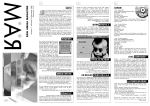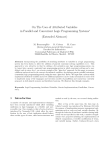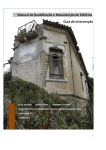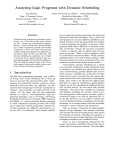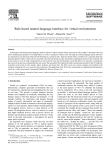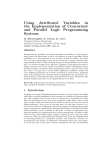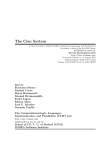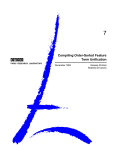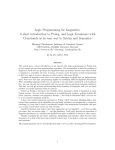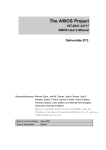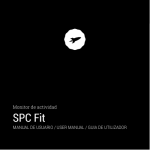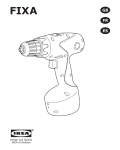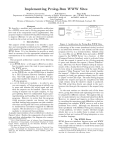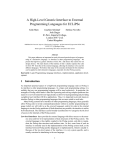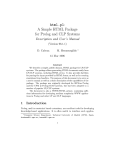Download (Ciao-)Prolog and the PiLLoW library
Transcript
Distributed WWW Programming using
(Ciao-)Prolog and the PiLLoW library
DANIEL CABEZA and MANUEL H E R M E N E G I L D O
CLIP Group
http://wwu). clip. dia.fi . upm. es - http://www. cliplab.org
Facultad de Informática
Universidad Politécnica de Madrid (UPM)
28660-Boadilla del Monte, Madrid, Spain
(e-mail: {dcabeza,herme}@f i .upm.es)
Abstract
We discuss from a practical point of view a number of issues involved in writing distributed
Internet and WWW applications using LP/CLP systems. We describe PiLLoW, a publicdomain Internet and WWW programming library for LP/CLP systems that we have
designed in order to simplify the process of writing such applications. PiLLoW provides
facilities for accessing documents and code on the WWW; parsing, manipulating and
generating HTML and XML structured documents and data; producing HTML forms;
writing form handlers and CGI-scripts; and processing HTML/XML templates. An important contribution of PÍ'LLOW is to model HTML/XML code (and, thus, the content
of WWW pages) as terms. The PÍ'LLOW library has been developed in the context of the
Ciao Prolog system, but it has been adapted to a number of popular LP/CLP systems,
supporting most of its functionality. We also describe the use of concurrency and a highlevel model of client-server interaction, Ciao Prolog's active modules, in the context of
WWW programming. We propose a solution for client-side downloading and execution of
Prolog code, using generic browsers. Finally, we also provide an overview of related work
on the topic.
Keywords: WWW, HTML, XML, CGI, HTTP, Distributed Execution, (Constraint)
Logic Programming.
1 Introduction
The wide diffusion of the Internet and the popularity of the "World Wide Web"
(Berners-Lee et al., 1994) - W W W - protocols are effectively providing a novel platform t h a t facilitates the development of new classes of portable and user-friendly
distributed applications. Good support for network connectivity and the protocols
and communication architectures of this novel platform are obviously requirements
for any programming tool to be useful in this arena. However, this alone may not be
enough. It seems natural t h a t significant parts of network applications will require
symbolic and numeric capabilities which are not necessarily related with distribution. Important such capabilities are, for example, high-level symbolic information
processing, dealing with combinatorial problems, and natural language processing
in general. Logic Programming (LP) (Kowalski, 1974; Colmerauer, 1975) and Constraint Logic Programming (CLP) systems (Jaffar & Lassez, 1987; Van Hentenryck,
1989; Colmerauer, 1990; M. Dincbas & Van Hentenryck, 1990; E C R C , 1993) have
been shown particularly successful at tackling these issues (see, for example, the
proceedings of recent conferences on the "Practical Applications of Prolog" and
"Practical Applications of Constraint Technology"). It seems natural to study how
LP/CLP technology fares in developing applications which have to opérate over the
Internet.
In fact, Prolog, its concurrent and constraint based extensions, and logic programming languages in general have many characteristics which appear to set
them particularly well placed for making an impact on the development of practical networked applications, ranging from the simple to the quite sophisticated.
Notably, LP/CLP systems share many characteristics with other recently proposed
network programming tools, such as Java, including dynamic memory management,
well-behaved structure and pointer manipulation, robustness, and compilation to
architecture-independent bytecode. Furthermore, and unlike the scripting or application languages currently being proposed (e.g., shell scripts, Perl, Java, etc.),
LP/CLP systems offer a quite unique set of additional features including dynamic
databases, search facilities, grammars, sophisticated meta-programming, and well
understood semantics.
In addition, most LP/CLP systems also already offer some kind of low level support for remote communication using Internet protocols. This generally involves
providing a sockets (ports) interface whereby it is possible to make remote data connections via the Internet's native protocol, TCP/IP. A few systems support higherlevel communication layers on top of this interface including linda-style blackboards
(e.g., SICStus Prolog (Carlsson, 1988), Ciao (Carro & Hermenegildo, 1999; Cabeza
& Hermenegildo, 1995; Hermenegildo & CLIP Group, 1994; Hermenegildo et al.,
1995a; Hermenegildo et al, 1999a; Hermenegildo et al, 1999b; Bueno et al, 1997),
BinProlog//U2-Prolog (Tarau, 1996; Bosschere, 1989), etc.) or shared variable-based
communication (e.g., KL1 (Chikayama et al, 1994), AKL (Janson & Haridi, 1991),
Oz (Smolka, 1994), Ciao (Hermenegildo et al, 1995b; Cabeza & Hermenegildo,
1995), etc.). In some cases, this functionality is provided via librarles, building on
top of the basic TCP/IP primitives. This is the case, for example, of the SICStus
and Ciao distributed linda-style interfaces. In fact, as we have shown in previous
work, shared-variable based communication can also be implemented in conventional systems via library predicates, by using attributed variables (Hermenegildo
et al., 1995b; Cabeza & Hermenegildo, 1995). In addition to these communication primitives, several systems offer concurrency and even higher-level abstractions (distributed objects, mobile code, ...) which are very useful for developing
general-purpose distributed applications.
Our concrete interest here is WWW applications. These applications generally
use specific high-level protocols (such as HTTP or FTP), data formats (such as HTML
or XML), and application architectures (e.g., the CGI interface) which are different from, e.g., the shared-variable or linda-based protocols typically used in other
types of distributed applications. In this paper we study how good support for
these WWW-related protocols, data formats, and architectures can be provided for
LP/CLP systems, building on the widely available interfaces to the basic TCP/IP
protocols. Our aim is to discuss from a practical point of view a number of the new
issues involved in writing WWW applications using LP/CLP systems, as well as
the architecture of some typical solutions. In the process, we will describe PjLLoW
("Programming in Logic Languages on the Web"), a public domain Internet/WWW
programming library for LP/CLP systems which, we argüe, significantly simplifies
the process of writing such applications. PjLLoW provides facilities for generating
HTML/XML structured documents by handling them as Herbrand terms, producing HTML forms, writing form handlers, processing HTML/XML templates, accessing and parsing WWW documents, etc. We also describe the architecture of some
relatively sophisticated application classes, using a high-level model of client-server
interaction, active modules (Cabeza & Hermenegildo, 1995). Finally we describe
an architecture for automatic L P / C L P code downloading for local execution, using
just the library and generic browsers.
Apart from the tutorial valué of the paper, we present a number of technical
contributions which include the idea of representing H T M L and XML code (and
structured text in general) as Prolog terms, the use of the logical variable in such
terms leading to a model of an "HTML témplate" (a pair comprising a t e r m with
free variables and a dictionary associating ñames to those variables), the notion
of "active logic modules" and its application to solving efficiency issues in CGI
interaction in a very simple way, the idea of "Prolog scripts" and its application
to CGIs, and the identification of a number of features t h a t should be added to
existing systems in order to facilítate the programming of W W W applications mainly concurrency.
T h e argument throughout the paper is t h a t , with only very small limitations in
functionality (which disappear when concurrency is added, as in systems such as
BinProlog//U 2 -Prolog, AKL, Oz, K L 1 , and Ciao Prolog), it is possible to add an
extremely useful I n t e r n e t / W W W programming layer to any L P / C L P system without making any significant changes in the implementation. We argüe t h a t this layer
can simplify the generation of applications in L P / C L P systems including active
W W W pages, search tools, content analyzers, indexers, software demonstrators,
collaborative work systems, MUDs and M O O s , code distributors, etc.
T h e purpose of the paper is also to serve as a tutorial, containing sufficient
information for developing relatively complex W W W applications in Prolog and
other LP and C L P languages using the PÍ'LLOW library. The PÍ'LLOW library has
been developed in the context of the Ciao Prolog system, but it has been adapted to
a number of other popular L P / C L P systems, supporting most of its functionality.
The Ciao Prolog system and the PiLLoW library can be freely downloaded from
h t t p : / / w w w . c l i p . d i a . f i . u p m . e s and h t t p : / / w w w . c l i p l a b . o r g .
2 Writing basic cgi-bin applications
The simplest way of writing W W W applications is through the use of the "Common
Gateway Interface" (CGI). A CGI executable is a standard executable file but such
t h a t the H T T P server (the program t h a t responds to H T T P requests in a machine
which serves a W W W site) can tell t h a t it in fact contains a program t h a t is to be
run, rather t h a n a document text t h a t is to be sent to the client (the browser) as
usual. The file can be distinguished by belonging to a special directory, commonly
named c g i - b i n , or by a special filename ending, such as . c g i . This is normally set
during configuration of the H T T P server. T h e basic idea behind the CGI interface
is illustrated in Figure 1. W h e n the user selects an address of a CGI executable
in a document, such as h t t p : / / w w w . x x x . y y y / c g i - b i n / h e l l o _ w o r l d (or perhaps
h t t p : / / w w w . x x x . y y y / f o o / h e l l o _ w o r l d . c g i ) the browser issues a standard document request (1). T h e HTTP server, recognizing t h a t it is a CGI executable rather
t h a n a document, starts the executable (2), and during such execution stores the
o u t p u t of the executable in a buffer (3). Upon termination of the executable, the
contents of the buffer (which should be in a format t h a t the browser can handle,
such as HTML) are returned to the browser as if a normal page with t h a t content
had been accessed (4).
HTTP
Server
Fig. 1. The CGI interface
T h e following is an example of how a very simple such executable can be written
in an L P / C L P language. T h e source might be as follows: 1
main
:write('Content-type: text/html'), ni,
write('<HTML>'),
write('Helio world.'),
write('</HTML>').
ni,
And the actual executable could be generated as usual, for example in the Ciao
system, using the standalone compiler, by writing at a UNIX shell " c i a o c - o
h e l l o _ w o r l d . c g i h e l l o _ w o r l d " . 2 The executable then has to be placed in an
appropriate place (accessible via an H T T P address by a browser) and have the
right permissions for being executed by the server (for example, in some systems
this means being executable by the user "nobody").
In systems which make executables through saved states (which usually have the
disadvantage of their generally large size), at the system prompt one could créate
the executable by writing something like:
?:-
compile('hello_world.pl'),
s a v e ( ' h e l l o _ w o r l d . c g i ' ) , main.
3 L P / C L P S c r i p t s for C G I A p p l i c a t i o n s
CGI executables are often small- to medium-sized programs t h a t perform relatively
simple tasks. This, added to the slow speed of the network connection in comparison with t h a t of executing a program (which makes program execution speed less
important) has made scripting languages (such as shell scripts or Perl) very popular
for writing these programs. The popularity is due to the fact t h a t no compilation
is necessary (extensive string handling capabilities also play an important role in
the case of Perl), and thus changes and updates to the program imply only editing
the source file.
Logic languages are, a priori, excellent candidates to be used as scripting languages. 3 However, the relative complication in making executables (needing in some
Note that in the examples presented, and in order to shorten them, the HTML code may
be slightly simplifled, and as a result of this it may not be completely standard-conforming.
However, the examples can be used as is with all popular browsers.
It often convenient to use options (such as ciaoc's - s or -S) which will genérate a standalone
executable which is independent of any librarles.
For example, the built-in grammars and databases greatly simplify many typical script-based
applications.
<form action="http://www.xxx.yyy/handler.cgi"
www
Browser
®
v_
>
i—i
i
1 [ZZl
Fig. 2. The Forms interface
systems to start the top-level, compile or consult the file, and make a saved state)
and the often large size of the resulting executables may deter CGI application
programmers. It appears convenient to provide a means for L P / C L P programs to
be executable as scripts, even if with reduced performance.
It is generally relatively easy to support scripts with the same functionality in
most L P / C L P systems. In Ciao, the program c i a o - s h e l l -which has also been
adapted to SlCStus (Hermenegildo, 1996)- accomplishes this task, by first loading
the file given to it as the first argument (but skipping the first lines and avoiding
loading messages) and then starting execution at m a i n / 1 (the argument provides
the list of command line options). Then, for example, in a Unix system, the foUowing
program can be run directly as a script without any need for compilation:
#!/usr/local/bin/ciao-shell
main(_) :write('Content-type: text/html'), ni,
write('<HTML>'),
write('Helio world.'),
write('</HTML>').
ni,
Note t h a t in some UNIX versions either the program c i a o - s h e l l must be included in the / e t c / s h e l l s listing or the first line should be replaced by these
two:
#!/bin/sh
e x e c c i a o - s h e l l $0 "$@"
T h e execution of Prolog scripts may be optimized in some systems. For example,
in Ciao, the first time a script is run it is also compiled and its bytecode is saved
to a file. At subsequent times, if the script has not changed, the object code is
retrieved from t h a t file, avoiding compilation or interpretation overhead.
4 Form Handling in H T T P
So far we have shown CGI executables which produce output, but this o u t p u t is not
a function of input coming from the request, which is obviously of limited interest.
CGI executables become most useful when combined with H T M L forms. H T M L
forms are H T M L documents (or parts of H T M L documents) which include special
fields such as text áreas, menus, radio buttons, etc. which allow providing input to
CGI executables. The steps involved in the handling of the input contained in a
form are illustrated in Figure 2. When a document containing a form is accessed
via a form-capable browser (Mosaic, Netscape, Lynx, etc.), the browser displays the
input fields, buttons, menus, etc. indicated in the document, and locally allows the
user to perform input by modifying such fields. However, this input is not ultimately
handled by the browser. Instead, it will be sent to a "handler" CGI program, which
can be anywhere on the net, and whose address must be given in the form itself
(1). Forms generally have a "submit" button such that, when pressed, the input
provided through the menus, text áreas, etc. is sent by the browser to the HTTP
server corresponding to the handler (2). Two methods for sending this input exist:
"GET" and "POST". In the meantime, the sending browser waits for a response
from that program, which should come in the form of a new HTML document.
The handler program is invoked in much the same way as a cgi-bin application (3),
except that the information from the form is supplied to the handler (in different
ways depending on the system, the method of invocation, and the contení type)
(4). This information is encoded in a predefined format, which relates each piece of
information to the corresponding field in the form, by means of a keyword associated
with each field. The handler then identifies the information corresponding to each
field in the original form, processes it, and then responds by writing an HTML
document to its standard output (5), which is forwarded by the server to the waiting
browser when the handler terminates (6). An important point to be noted is that,
as with simple cgi-bin applications, the handler is started and should terminate for
each transaction. The reader is referred, for example, to (Grobe & Naseer, 1998)
for a more complete introduction to CGI scripts and HTML forms.
5 Writing Form Handlers with PíLLoW
The only complication in writing form handlers compared to writing simple CGI
applications is the need to capture and parse the form data. As we said before, this
data can be provided in several ways, depending on the system and the method
used to invoke the form, and is encoded with escape sequences. It is relatively easy
to write a Prolog program to parse such input (using, for example, definite clause
grammars -DCGs). The PiLLoW library provides some predicates which do this
and simplify the whole task, hiding the low-level protocol behind. The principal
predicates provided include:
get_form_input (Dic) Translates input from the form (with either the POST or
GET methods, and even with CONTENT_TYPE multipart/form-data) to a dictionary Dic of attribute=value pairs. It translates empty va7ues (which indicate
only the presence of an attribute) to the atom ' $empty', valúes with more than
one line (from text áreas or files) to a list of lines as strings, the rest to atoms or
numbers (using name/2). This is implemented using DCG parsers.
get_form_ valué (Dic, Var, Val) Gets valué Val for attribute Var in dictionary
Dic. Does not fail: valué is ' ' if not found (this simplifies merging form producers
and form handlers, see later).
form_empty_value(V) Useful to check that a valué V from a text área is empty
(filters spaces, newlines, linefeeds, etc.).
form_default(Val,Default,NewVal)
Useful when a form is only partially filled
(and also in the first invocation of a combined form handler/producer - see
Section 7). If the valué of Val is empty then NewVal=Default, else NewVal=Val.
my_url (URL) Returns in URL the Uniform Resource Locator (WWW address) of
this cgi executable.
form_request_method(Method) Returns in Method the method of invocation of
the form handler ("GET" or "POST").
For example, suppose we want to make a handler which implements a datábase
of telephone numbers and is queried by a form including a single entry field with
ñame person._n.ame. The handler might be coded as follows:
#!/usr/local/bin/ciao-shell
:- include(library(pillow)).
main(_) :-
get_form_input(Input),
get_form_value(Input,person_name,Ñame) ,
write('Content-type: text/lrtml'), ni, ni,
write('<HTMLXTITLE>Telephone database</TITLE>'), n i ,
write('<IMG SRC="phone.gif">'),
w r i t e ( ' <H2>Telephone database</H2XHR>' ) ,
write_info(Name) ,
write('</HTML>').
write_info(Name) : form_empty_value(Name) ->
write('You have t o provide a ñame.')
; phone(Name, Phone) ->
write('Telephone number of <B>'),
write(Name),
write('</B>: ' ) ,
write(Phone)
; w r i t e ( ' N o telephone number a v a i l a b l e for <B>'),
write(Ñame),
write('</B>.').
phone(daniel, ' 3 3 6 - 7 4 4 8 ' ) .
phone(manuel, ' 3 3 6 - 7 4 3 5 ' ) .
phone(sacha,
'543-5316').
The code above is quite simple. On the other hand, the interspersion throughout
the text of calis to w r i t e with HTML markup inside makes the code somewhat
inelegant. Also, there is no separation between computation and input/output, as
is normally desirable. It would be much preferable to have an encoding of HTML
code as Prolog terms, which could then be manipulated easily in a more elegant way,
and a predicate to transíate such terms to HTML for output. This functionality,
provided by the PÍ'LLOW library, is presented in the next section.
6 Handling HTML as Prolog Terms
Since LP/CLP systems perform symbolic processing using Herbrand terms, it seems
natural to be able to handle HTML code directly as terms. Then, such structures
only need to be translated by appropriate predicates to HTML code when they
need to be output. In general, this relationship between HTML code and Prolog
terms allows viewing any WWW page as a Herbrand term. The predicates which
provide this functionality in PiLLoW are:
o u t p u t J r t m l ( F ) Accepts in F an H T M L term (or a list of H T M L terms) and
sends to the standard o u t p u t the text which is the rendering of the term(s) in
H T M L format.
h t m l 2 t e r m s ( C i i a r s , Terms)
(also, x m l 2 t e r m s / 2 ) Relates a list of H T M L
(resp. XML) terms and a list of ASCII characters which are the rendering of
the terms in H T M L format. This predicate is reversible (but it normalizes in
the reverse direction -see later). o u t p u t _ h t m l / 2 uses this predicate to transform
H T M L terms in characters. Again, this is implemented via D C G parsing.
In an HTML term certain atoms and structures represent special functionality
at the H T M L level. An H T M L term can be recursively a list of H T M L terms. T h e
following are legal H T M L terms:
helio
[ h e l i o , world]
[ " T h i s i s an " , em('HTML'), " t e r m " ]
When converting H T M L terms to characters, h t m l 2 t e r m s / 2 translates special
structures into the corresponding format in H T M L , applying itself recursively to
their arguments. Strings are always left unchanged. H T M L terms may contain logic
variables, provided they are instantiated before the t e r m is translated or output.
This allows creating documents piecemeal, back-patching of references in documents, etc.
In the following sections we list the meaning of the principal Prolog structures
t h a t represent special functionality at the H T M L level. Only special atoms are
translated, the rest are assumed to be normal text and will be passed through to
the H T M L document.
6.1
General
Structures
Basically, H T M L has two kinds of components: H T M L elements and H T M L environments. An H T M L element has the form "<NAME Attributes
>" were ÑAME
is the ñame of the element and Attributes is a (possibly empty) sequence of attributes, each of t h e m being either an attribute ñame or an attribute assignment
as name="Valué".
An H T M L environment has the form "<NAME . A t t r i b u t e s > Text </NAME>"
were ÑAME is the ñame of the environment an Attributes has the same form as
before.
T h e general Prolog structures t h a t represent these two H T M L constructions are:
Afame $Atts ( ' $ / 2 ' is defined as an infix, binary operator.) Represents an H T M L
element of ñame Ñame and attributes Atts, were Atts is a (possibly empty) list
of attributes, each of t h e m being either an atom or a structure ñame=valué.
For
example, the term
img$[src='images/map.gif',alt="A
map",ismap]
is translated into the H T M L source
<img src="images/map.gif"
alt="A map" ismap>
Note t h a t H T M L is not case-sensitive, so we can use lower-case atoms.
ñame ( T e x t ) (A term with functor n a m e / 1 and argument Text) Represents an
H T M L environment of ñame ñame and included text Text. For example, the
term
address('[email protected]')
is translated into the H T M L source
<address>[email protected]</address>
ñame (Atts, Text) (This is a term with functor name/2 and arguments Atts and
Text) Represents an HTML environment of ñame ñame, attributes Atts and
included text Text. For example, the term
a([href='http://www.clip.dia.fi.upm.es/'],"Clip
home")
represents the HTML source
<a h r e f = " h t t p : / / w w w . c l i p . d i a . f i . u p m . e s / " > C l i p
home</a>
erLv(JVame,^tts, Text) Equivalent to Ñame (Atts, Text) .
begin(JVame,Atts) It translates to the start of an HTML environment of ñame
Ñame and attributes Atts. There exists also a begin (Ñame) structure. Useful,
in conjunction with the next structure, when including in a document output
generated by an existing piece of code (e.g. Ñame = pre). Its use is otherwise
discouraged.
end(JVame) Translates to the end of an HTML environment of ñame Ñame.
Now we can rewrite the previous example as follows (note how the use of the
logic variable Response allows injecting the result of the cali to r e s p o n s e / 1 into
the output term, using unification):
#!/usr/local/bin/ciao-shell
:- include(library(pillow)).
main(_) :get_form_input(Input),
get_form_value(Input,person_name,Ñame),
response(Ñame,Response),
output_html([
'Content-type: t e x t / h t m l \ n \ n ' ,
html([title('Telephone datábase'),
img$[src='phone.gif'],
h2('Telephone d a t á b a s e ' ) ,
hr$ [] ,
R e s p o n s e ] ) ] ) . */„*/„ Using t h e l o g i c v a r i a b l e .
response(Ñame, Response) : form_empty_value(Name) ->
Response = 'You nave t o provide a ñame.'
; phone(Ñame, Phone) ->
Response = ['Telephone number of ' , b ( N a m e ) , ' : ',Phone]
; Response = ['No telephone number a v a i l a b l e for ' , b ( N a m e ) , ' . ' ] .
phone(daniel, ' 3 3 6 - 7 4 4 8 ' ) .
phone(manuel, ' 3 3 6 - 7 4 3 5 ' ) .
phone(sacha,
'543-5316').
Any HTML construction can be represented with these structures (except comments and declarations, which could be included as atoms or strings), but the
P Í L L O W library provides additional, specific structures to simplify HTML creation.
6.2 Specific
Structures
In this section we will list some special structures for HTML which PÍ'LLOW understands. While in many cases using the general structures (with the native HTML
ñames) is probably good practice, using specific structures such as these can sometimes be convenient. Also, some of these structures have special functionality (e.g.,
prolog_term/l). A predicate html_expansion/2 is provided which allows defining new structures (tables, layers, etc). Specific structures include (the reader is
referred to the PÍ'LLOW manual for a full listing):
s t a r t Used at the beginning of a document (translates to <html>).
end Used at the end of a document (translates to </html>).
— Produces a horizontal rule (translates to <hr>).
\ \ Produces a line break (translates to <br>).
$ Produces a paragraph break (translates to <p>).
comment (Comment) Used to insert an HTML comment (translates to
<!— Comment —>).
d e c l a r e ( D e c l ) Used to insert an HTML declaration - seldom used (translates to
<\Decl>).
image (.Addr) Used to include an image of address (URL) Addr (translates to an
<img> element).
image(Addr,Atts) As above with the list of attributes Atts.
ref (Addr, Text) Produces a hypertext link, Addr is the URL of the
referenced resource, Text is the text of the reference (translates to
<a href="Addr">Text</a>).
l a b e l (Label, Text) Labels Text as a target destination with label Label (translates to <a name="Labeí">Text</a>).
heading(JV, Text) Produces a heading of level N (1 < N < 6), Text is the text to
be used as heading - useful when one wants a heading level relative to another
heading (translates to a <hJV> environment).
i t e m i z e ( í t e m s ) Produces a list of bulleted Ítems, ítems is a list of corresponding
HTML terms (translates to a <ul> environment).
enumérate (ítems) Produces a list of numbered Ítems, ítems is a list of corresponding HTML terms (translates to an <ol> environment).
d e s c r i p t i o n ( D e f s ) Produces a list of defined Ítems, Defs is a list whose elements
are definitions, each of them being a Prolog sequence (composed by ' , ' / 2 operators). The last element of the sequence is the definition, the other (if any) are
the defined terms (translates to an <dl> environment).
nice_itemize (Img, ítems) Produces a list of bulleted Ítems, using the image Img
as bullet. The predicate icon_address/2 provides a colored bullet.
pref ormatted(Text) Used to include preformatted text, Text is a list of HTML
terms, each element of the list being a line of the resulting document (translates
to a <pre> environment).
verbatim(Text) Used to include text verbatim, special HTML characters
(<,>,&,") are translated into its quoted HTML equivalent.
prolog_term(Term) Includes any prolog term Term, represented in functional
notation. Variables are output as _.
n i Used to include a newline in the HTML source (just to improve human readability).
entity(JVame) Includes the entity of ñame Ñame (ISO-8859-1 special character).
cgi_reply This is not HTML, rather, the CGI protocol requires this contení
descriptor to be used by CGI executables (including form handlers) when replying
(translates to "Content-type: t e x t / h t m l " ) .
pr Includes in the page a graphical logo with the message "Developed using the
PÍ'LLOW Web programming library", which points to the manual and library
source.
With these additional structures, we can rewrite the previous example as follows
(note that in this example the use of heading/2 or h 2 / l is equally suitable):
#!/usr/local/bin/ciao-shell
:- include(library(pillow)).
main(_) :-
get_form_input(Input),
get_form_value(Input,person_name,Ñame) ,
response(Name,Response),
output_html([
cgi_reply,
start,
title('Telephone datábase'),
image('phone.gif'),
heading(2,'Telephone d a t á b a s e ' ) ,
,
Response,
end]).
response(Ñame, Response) : form_empty_value(Name) ->
Response = 'You nave t o provide a ñame.'
; phone(Ñame, Phone) ->
Response = ['Telephone number of ' , b ( N a m e ) , ' : ',Phone]
; Response = ['No telephone number a v a i l a b l e for ' , b ( N a m e ) , ' . ' ] .
phone(daniel, ' 3 3 6 - 7 4 4 8 ' ) .
phone(manuel, ' 3 3 6 - 7 4 3 5 ' ) .
phone(sacha,
'543-5316').
We have not included above the specific structures for creating forms. They are
included and explained in the following section.
6.3 Specific
Structures
for
Forms
In this section we explain the structures which represent the various elements related
to forms:
s t a r t _ f orm (.Addr [, .Atts]) Specifies the beginning of a form. Addr is
the address (URL) of the program that will handle the form, and
Atts other attributes of the form, as the method used to invoke it.
If Atts is not present the method defaults to POST. (Translates to
<form action="Addr" A t t s >.)
s t a r t _ f orm Specifies the beginning of a form without assigning address to the
handler, so that the form handler will be the cgi-bin executable producing the
form.
end_f orm Specifies the end of a form (translates to </f orm>).
checkbox (JVame, S t a t e ) Specifies an input of type checkbox with ñame Ñame,
State=on if the checkbox is initially checked (translates to an <input> element).
r a d i o (JVame, Valué,Selected)
Specifies an input of type r a d i o with ñame Ñame
(several radio buttons which are interlocked must share their ñame), Valué is the
the valué returned by the button, if Selected= Valué the button is initially checked
(translates to an <input> element).
input (Type, .Atts) Specifies an input of type Type with a list of attributes Atts.
Possible valúes of Type are t e x t , hidden, submit, r e s e t , . . . (translates to an
< input > element).
t e x t i n p u t (Ñame, Atts, Text) Specifies an input text área of ñame Ñame. Text
provides the default text to be shown in the área, Atts a list of attributes (translates to a <textarea> environment).
option(JVame, Val,Options)
Specifies a simple option selector of ñame Ñame,
Options is the list of available options and Val is the initial selected option
(if Val is not in Options the first item is selected) (translates to a <select>
environment).
memi(Name,Atts,ítems)
Specifies a menú of ñame Ñame, list of attributes Atts
and list of options ítems. The elements of the list ítems are marked with the
prefix operator '$' to indicate that they are selected (translates to a <select>
environment).
For example, in order to genérate a form suitable for sending input to the previously described phone datábase handler one could execute the following goal:
output_html([
start,
title('Telephone datábase'),
heading(2,'Telephone d a t á b a s e ' ) ,
$,
start_form('http://www.clip.dia.fi.upm.es/cgi-bin/phone_db.pl'),
'Click here, enter ñame of clip member, and press Return:',
w,
input(text,[name=person_name,size=20] ) ,
end_form,
end]).
Of course, one could have also simply written directly the resulting HTML document:
<html>
<title>Telephone database</title>
<h2>Telephone database</h2>
<P>
<form method="POST"
action="http://www.clip.dia.fi.upm.es/cgi-bin/phone_db.pl">
Click here, enter ñame of clip member, and press Return:
<br>
<input type="text" name="person_name" size="20">
</form>
</html>
7 Merging the Form Producer and the Handler
An interesting practice when producing HTML forms and handlers is to merge the
operation of the form producer and the handler into the same program. The idea is
to produce a generalized handler which receives the form input, parses it, computes
the answer, and produces a new document which contains the answer to the input,
as well as a new form. A special case must be made for the first invocation, in
which the input would be empty, and then only the form should be generated. The
following is an example which merges the producer and the handler for the phones
datábase: 4
#!/usr/local/bin/ciao-shell
:- include(library(pillow)).
main(_) :get_form_input(Input),
get_form_value(Input,person_name,Ñame) ,
response(Name,Response),
output_html([
cgi_reply,
start,
title('Telephone datábase'),
image('phone.gif'),
heading(2,'Telephone datábase'),
,
Response,
start_form,
'Click here, enter ñame of clip member, and press Return:',
w,
input(text,[name=person_name,size=20] ) ,
end_form,
end]).
response(Ñame, Response) : form_empty_value(Name) ->
Response = []
; phone(Ñame, Phone) ->
Response = [ ' T e l e p h o n e number of ' , b ( N a m e ) , ' : ' , P h o n e , $ ]
; R e s p o n s e = ['No t e l e p h o n e number a v a i l a b l e f o r ' , b ( N a m e ) , ' . ' , $ ] .
phone(daniel,
phone(manuel,
phone(sacha,
'336-7448').
'336-7435').
'543-5316').
This combination of the form producer and the handler allows producing applications t h a t give the impression of being interactive, even if each step involves starting
and running the handler to completion. Note t h a t forms can contain fields which
are not displayed and are passed as input to the next invocation of the handler.
This allows passing state from one invocation of the handler to the next one.
Finally, a note about testing and debugging CGI scripts: this is unfortunately
not as straightforward as it could be. Useful techniques include carefuUy checking
permissions, looking at the d a t a logs of the server, replacing predicates such as
g e t _ f o r m _ . . . with versions t h a t print what is really being received, etc.
8
Templates
A problem in the previous programs is t h a t the layout of the o u t p u t page is not
easily configurable - i t is hard-coded in the source and can only be changed by
4
Notice that when only one text field exists in a form, the form can be submitted by simply
pressing "Return" inside the text field.
modifying the program. This is something that a normal user (or even an expert
programmer if the size of the program is large) may not want to do. In order to
address this, PiLLoW provides a facility for reading in "HTML templates" (also
XML templates), and converting them into a term format in which it is very natural
to manipúlate them. An HTML témplate is a file which contains standard HTML
code, but in which "slots" can be defined and given an identifier by means of a
special tag. These slots represent parts of the HTML code in which other HTML
code can be inserted. Once the HTML témplate is read by PiLLoW, such slots
appear as free logic variables in the corresponding PÍ'LLOW terms. In this way, the
user can define a layout with an HTML editor of choice, taking care of marking the
"left out" parts with given ñames. These parts will then be filled appropriately by
the program. The functionahty associated with parsing such terms is encapsulated
in the following predicate:
html_template(Ciiars, Terms, Dict) Parses the string Chars as the contents
of an HTML témplate and unifies Terms with the list of HTML terms comprised
in the témplate, substituting occurrences of the special tag <V>name</V> with
prolog variables. Dict is instantiated to the dictionary of such substitutions, as a
list of name= Variable pairs.
In the following example a témplate file called Tlf DB. html is assumed to hold the
formatting of the output page, defining an HTML variable called "response" which
will be substituted by the response of the CGI program. Note that the predicate
f i l e _ t o _ s t r i n g / 2 (defined in Ciao library f i l e _ u t i l s ) reads a file and returns
in its second argument the contents of the file as a list of character codes. Note also
that calling html_template/3 with the third argument instantiated to [response
= Response] has the effect of instantiating the "slot" in HTML_terms to the contents
of Response (this makes use of the fact that there is only one slot on the témplate;
normally, a cali to member/2 is used to lócate the appropriate name= Variable pair).
#!/usr/local/bin/ciao-shell
:- include(library(pillow)).
:- use_module(library(file_utils)).
main(_) :get_form_input(Input),
get_form_value(Input,person_name,Ñame),
response(Ñame,Response),
f i l e _ t o _ s t r i n g C T l f D B . h t m l ' , Contents) ,
html_template(Contents, HTML_terms, [response = Response]),
output_html([cgi_reply|HTML_terms]).
response(Ñame, Response) : form_empty_value(Name) ->
Response = []
; phone(Name, Phone) ->
Response = ['Telephone number of ' , b ( N a m e ) , ' : ',Phone,$]
; Response = ['No telephone number a v a i l a b l e for ' , b ( N a m e ) , ' . ' , $ ] .
phone(daniel, ' 3 3 6 - 7 4 4 8 ' ) .
phone(manuel, '336-7435') .
phone(sacha,
'543-5316').
An example of the contents of the témplate file could be:
<HTMLXHEADXTITLE>Telephone database</TITLEX/HEAD>
<BODY background="bg.gif">
<IMG src="phone.gif">
<H2>Telephone database</H2>
<HR>
<V>response</V>
<FORM method="POST">
Click h e r e , e n t e r ñame of c l i p member, and p r e s s Return:<BR>
<INPUT t y p e = " t e x t " name="person_name" size="20"x/FORM>
</B0DY>
</HTML>
9 Accessing W W W d o c u m e n t s
The facilities presented in the previous sections allow generating HTML documents,
including forms, and handling the input coming from forms. In many applications
such as search tools, content analyzers, etc., it is also desirable to be able to access
documents on the Internet. Such access is generally accomplished through protocols
such as FTP and HTTP which are built on top of TCP/IP. In LP/CLP systems which
have TCP/IP connectivity (i.e., a sockets/ports interface) the required protocols
can be easily coded in the source language using such facilities and DCG parsers.
At present, only the HTTP protocol is supported by PjLLoW. As with HTML code,
the library uses an internal representation of Uniform Resource Locators (URLs), to
be able to manipúlate them easily, and provides predicates which transíate between
the internal representation and the textual form. The facilities provided by PjLLoW
for accessing WWW documents include the following predicates:
u r l _ i n f o(URL,Info) Translates a URL URL to an internal structure Info which
details its various components and vice-versa. For now non-HTTP URLs make
the predicate fail. E.g.
url_info('http://www.foo.com/bar/scooby.txt',Info)
gives Info = h t t p ( ' w w w . f o o . c o m ' , 8 0 , " / b a r / s c o o b y . t x t " ) ,
url_info(URL, http('www.foo.com',2000,"/bar/scooby.txt")
gives URL = "http://www.foo.com:2000/bar/scooby.txt" (a string).
u r l _ i n f o_relative(URL, Baselnfo, Inf o) Translates a relative URL URL which
appears in the HTML page referred to by Baselnfo (given as an u r l _ i n f o structure) to a complete u r l _ i n f o structure Jnfo. Absolute URLs are translated as
with the previous predicate. E.g.
url_info_relative("/guu/intro.html",
h t t p ( ' w w w . f o o . c o m ' , 8 0 , " / b a r / s c o o b . h t m l " ) , Info)
gives Info = h t t p ( ' w w w . f o o . c o m ' , 8 0 , " / g u u / i n t r o . h t m l " )
url_info_relative("dadu.html",
h t t p ( ' w w w . f o o . c o m ' , 8 0 , " / b a r / s c o o b . h t m l " ) , Info)
gives Info = http('www.foo.com',80,"/bar/dadu.html").
url_query (Dic,Args) Translates a list of attribute=value pairs Dic (in the same
form as the dictionary returned by get_f orm_input/l) to a string Args for appending to a URL pointing to a form handler.
fetch_url(¡7fíL,fíequest,.Response) Fetches a document from the Internet. URL
is the Uniform Resource Locator of the document, given as a u r l _ i n f o structure.
Request is a list of options which specify the parameters of the request, Response
is a list which includes the parameters of the response. The request parameters
available include:
head To specify that we are only interested in the header.
timeout (Time) Time specifies the máximum period of time (in seconds) to wait
for a response. The predicate fails on timeout.
if_modified_sin.ce(Date) Get
document
only if newer than Date. An example of a structure that represents a date
is d a t e ( ' T u e s d a y ' , 1 5 , ' J a n u a r y ' , 1 9 8 5 , ' 0 6 : 1 4 : 0 2 ' ) .
user_agent (JVame) Provide a user-agent field.
auth.orization.(Scheme,Pararas) Provides an authentication field when accessing restricted sites.
ñame(Param) Any other functor translates to a field of the same ñame (e.g.
from('userOmachine')).
The parameters which can be returned in the response list include (see the
HTTP/1.0 definition for more information):
content (Content) Returns in Content the actual document text, as a list of
characters.
s t a t u s (Type,Code,Phrase)
Gives the status of the response. Type can be any
of informational, success, r e d i r e c t i o n , r e q u e s t _ e r r o r , s e r v e r _ e r r o r or
extension_code, Code is the status code and Pirase is a textual explanation
of the status.
pragma(Data) Miscellaneous data.
message_date(Date) The time at which the message was sent.
location(C7fiL) The document has moved to this URL.
h t t p _ s e r v e r ( S e r v e r ) Identifies the server responding.
allow(methods) List of methods allowed by the server.
last_modified(Date) Date/time at which the sender believes the resource was
last modified.
e x p i r e s (Date) Date/time after which the entity should be considered stale.
content_type( Type, Subtype, Pararas) Returns the MIME type/subtype of the
document.
conterLt_eiicoding(Type) Encoding of the document (ifany).
conterLt_length(Leijgtlj) Length is the size of the document, in bytes.
a u t h e n t i c a t e ( C h a l l e n g e s ) Request for authentication.
html2terms(Chars, Terms) We have already explained how this predicate transforms HTML terms to HTML format. Used the other way around it can parse
HTML code, for example retrieved by f e t c h _ u r l . The resulting list of HTML
terms Terms is normalized: it contains only comment/1, d e c l a r e / 1 , env/3 and
$/2 structures.
For example, a simple fetch of a document can be done as follows:
url_info('http://www.foo.com',UI), fetch_url(UI,[],R),
member(content(C),R), html2terms(C, HTML_Terms).
Note that if an error occurs (the document does not exist or has moved, for example)
this will simply fail. The following cali retrieves a document if it has been modified
since October 6, 1999:
fetch_url(http('www.foo.com',80,"/doc.html"),
[if_modified_since('Wednesday',6,'October',1999,'00:00:00')],R).
This last one retrieves the header of a document (with a timeout of 10 seconds) to
get its last modified date:
fetch_url(http('www.foo.com',80,"/last_news.html"),[head,timeout(10)],R),
member(last_modified(Date),R).
The following is a simple application illustrating the use of f e t c h _ u r l and
html2terms. The example defines check_links(UñL,BadLinks). The predicate
fetches the HTML document pointed to by URL and scours it to check for links
which produce errors when followed. The list BadLinks contains all the bad links
found, stored as compound terms of the form: b a d l i n k ( L i n k , E r r o r ) where Link
is the problematic link and Error is the error explanation given by the server.
check_links(URL,BadLinks) :url_info(URL,URLInfo),
fetch_url(URLInfo,[],Response),
member(content_type(text,html,_),Response),
member(content(Content),Response),
html2terms(Content,Terms),
check_source_links(Terms,URLInfo,[],BadLinks).
check_source_links([],_,BL,BL).
check_source_links([E|Es],BaseURL,BLO,BL) :check_source_linksl(E,BaseURL,BLO,BLl),
check_source_links(Es,BaseURL,BLl,BL).
check_source_linksl(env(a,AnchorAtts,_),BaseURL,BLO,BL) : member((href=URL),AnchorAtts), ! ,
check_link(URL,BaseURL,BLO,BL).
check_source_linksl(env(_Name,_Atts,Env_html),BaseURL,BLO,BL) :- !,
check_source_links(Env_html,BaseURL,BLO,BL).
check_source_linksl(_,_,BL,BL).
check_link(URL,BaseURL,BLO,BL) :url_info_relative(URL,BaseURL,URLInfo), ! ,
fetch_url_status(URLInfo,Status,Pirrase),
( Status \== success ->
ñame (P, Pirrase) ,
ñame(U,URL),
BL = [badlink(U,P)IBLO]
; BL = BLO
).
check_link(_,_,BL,BL).
fetch_url_status(URL,Status,Pirrase) : fetch_url(URL,[head,timeout(20)],Response),
member(status(Status,_,Pirrase),Response).
fetch_url_status(_,timeout,"Timeout").
! ,
10 Providing Code Through the W W W
A facility which can be easily built on top of the primitives presented so far is that
of "remote WWW modules," i.e., program modules which reside on the net at a
particular HTTP address in the same way that normal program modules reside
in a particular location in the local file system. This allows for example always
fetching the most recent versión of a given library (e.g., PÍ'LLOW) when a program
is compiled. For example, the form handler of Section 6.1, if rewritten as
#!/usr/local/bin/ciao-shell
<form a c t i o n = " h t t p : / / w w w . x x x . y y y / a m _ i n t e r . c g i
®
v.
>
WWW
Browser
i—i
i—i
i=i
predícate(Argl,Arg2,...,ArgN)
Fig. 3. The Forms Interface using Active Modules
:- use_module('http://www.clip.dia.fi.upm.es/lib/pillow.pl').
main(_) :get_form_input(Input),
get_form_value(Input,person_name,Ñame),
would load the current versión of the library each time it is executed. This generalized module declaration is just syntactic sugar, using expand_term, for a document
fetch, using f e t c h _ u r l , followed by a standard use_module declaration. It is obviously interesting to combine this facility with caching strategies. An interesting
(and straightforward to implement) additional feature is to fetch remote byte-code
(as generally done by use_module), if available, but this is only possible if the two
systems use the same byte-code (this can normally be checked easily in the bytecode itself). Also, it may be interesting to combine this type of code downloading
with W W W document accesses, so t h a t code is downloaded automatically when a
particular document is fetched. This issue is addressed in Section 12. Finally, there
are obvious security issues related to downloading code in general, which can be
addressed with standard techniques such as security signatures.
11 A H i g h - L e v e l M o d e l of C l i e n t - S e r v e r I n t e r a c t i o n : A c t i v e M o d u l e s
Despite its power, the cgi-bin interface also has some shortcomings. T h e most serious is perhaps the fact t h a t the handler is started and expected to terminate for
each interaction. This has two disadvantages. First, no state is preserved from one
query to the next. However, as mentioned before, this can be fixed by passing the
state through the form (using hidden fields), by saving it in a temporary file at the
server side, by using "cookies", etc. Second, and more importantly, starting and
stopping the application may be inefficient. For example, if the idea is to query
a large datábase or a n a t u r a l language understanding system, it may take a long
time to start and stop the system. In order to avoid this we propose an alternative
architecture for cgi-bin applications (a similar idea, although not based on the idea
of active modules, has been proposed independently by Ken Bowen (Bowen, 1996)).
T h e basic idea is illustrated in Figure 3. The operation is identical to t h a t of
standard form handlers, as illustrated in Figure 2, up to step 3. In this step, the
handler started is not the application itself, but rather an interface to the actual
application, which is running continuously and thus contains state. Thus, only the
interface is started and stopped with every transaction. The interface simply passes
the form input received from the server (4) to the running application (5) and then
forwards the output from the application (6) to the server before terminating, while
the application itself continúes running. Both the interface and the application can
be written in LP/CLP, using the predicates presented. The interface can be a simple
script, while the application itself will be typically compiled.
An interesting issue is that of communication between interface and application.
This can of course be done through sockets. However, as a cleaner and much simpler alternative, the concept of active modules (Cabeza & Hermenegildo, 1995) can
be used to advantage in this application. An active module (or an active object,
if modularity is implemented via objects) is an ordinary module to which computational resources are attached (for example, a process on a UNIX machine), and
which resides at a given (socket) address on the network.5 Compiling an active
module produces an executable which, when running, acts as a server for a number of relations, which are the predicates exported by the module. The relations
exported by the active module can be accessed by any program on the network
by simply "loading" the module and thus importing such "remote relations." The
idea is that the process of loading an active module does not involve transferring
any code, but rather setting up things so that calis in the local module are executed as remote procedure calis to the active module, possibly over the network.
Except for compiling it in a special way, an active module is identical from the
programmer point of view to an ordinary module. Also, a program using an active
module imports it and uses it in the same way as any other module, except that it
uses "use_active_module" rather than "use_module" (see below). Also, an active
module has an address (network address) which must be known in order to use it.
The address can be announced by the active module when it is started via a file or
a ñame server (which would be itself another active module with a fixed address).
We now present the constructs related to active modules in Ciao:
: - use_active_module(Module,Predicates) A declaration used to import the
predicates in the list Predicates
from the active module Module. From this
point on, the code should be written as if a standard use_module/2 declaration
had been used. The declaration needs the following predicate to be accessible
from the module.
module_address(Module,Address) This predicate must return in Address the
address of Module, for any active module imported in the code. There are a
number of standard librarles defining versions of this predicate.
save_addr_actmod(4ddress) This predicate should define a way to publish
Address, to be used in active modules (the ñame of the active module is taken
as the ñame of the current executable). There are a number of standard librarles
defining versions of this predicate, which are in correspondence with the librarles
which define versions of the previous predicate.
make_actmod(ModuleFile,Publis.hModule) Makes an active module executable
from the module residing in ModuleFile, using address publish module of
ñame PublishModule. When the executable is run (for example, at the operating system level by "Module &"), a socket is created and the hook predicate save_addr_actmod/l mentioned above (which is supposed to be defined in
6
It is also possible to provide active modules via a W W W address. However, we find it more
straightforward to simply use socket addresses. In any case, this is generally hidden inside the
access method and can be thus made transparent to the user.
PublishModule) is called in order to export the active module address as required. Then, a standard driver is run to attend network requests for the module
exported predicates. Note that the code of ModuleFile does not need to be
written in any special way.
This scheme is very flexible, allowing to completely configure the way active
modules are located. This is accomplished by writing a pair of libraries, one defining the way an active module address is published, and a second defining the way
the address of a given active module is found. For example, the Ciao standard libraries include as an example an implementation (libraries f ilebased_publishand
f i l e b a s e d _ l o c a t e ) which uses a directory accessible by all the involved machines
(via NFS) to store the addresses of the active modules, and the module_address/2
predícate examines this directory to find the required data. Other solutions provided
as examples include posting the address at a WWW address (webbased_publish
/ webbased_locate), and an implementation of a ñame server, that is, another
active module (this one with a known, fixed address) that records the addresses of
active modules and supplies this data to the modules that import it, serving as a
contact agency between servers and clients.
From the implementation point of view, active modules are essentially daemons:
Prolog executables which are started as independent processes at the operating
system level. In the Ciao system library, communication with active modules is
implemented using sockets (thus, the address of an active module is a UNIX socket
in a machine). Requests to execute goals in the module are sent through the socket
by remote programs. When such a request arrives, the process running the active
module takes it and executes it, returning through the socket the computed results.
These results are then taken by the remote processes.
Thus, when the compiler finds a use_active_module declaration, it defines the
imported predicates as remote calis to the active module. For example, if the predícate P is imported from the active module M, the predícate would be defined as
P : - module_address (M, A) , remote_call(A,.P)
Compiling the following code as an active module, by writing at the Ciao
toplevel "make_actmod(phone_db, ' a c t m o d s / f i l e b a s e d _ p u b l i s h ' ) " (or, using
the standalone compiler, by executing "ciaoc - a ' a c t m o d s / f i l e b a s e d _ p u b l i s h '
phone_db"), creates an executable phone_db which, when started as a process (for
example, by typing "phone_db &" at a UNIX shell prompt) saves its address (Le.,
that of its socket) in file phone_db. addr and waits for queries from any module
which "imports" this module (it also provides a predícate to dynamically add information to the datábase):
: - module(phone_db,[response/2,add_phone/2] ) .
response(Name, Response) : form_empty_value(Name) ->
Response = 'You nave t o provide a ñame.'
; phone(Name, Phone) ->
Response = ['Telephone number of ' , b ( N a m e ) , ' : ',Phone]
; Response = ['No telephone number a v a i l a b l e for ' , b ( N a m e ) , ' . ' ] .
add_phone(Name, Phone) : assert(phone(Ñame, Phone)).
: - dynamic phone/2.
phone(daniel, ' 3 3 6 - 7 4 4 8 ' ) .
phone(manuel, ' 3 3 6 - 7 4 3 5 ' ) .
phone(sacha,
'543-5316').
The following simple script can be used as a cgi-bin executable which will be the
active module interface for the previous active module. When started, it will process
the form input, issue a cali to response/2 (which will be automatically handled
by the phone_db active module), and produce a new form before terminating. It
will lócate the address of the phone_db active module via the module_address/2
predicate defined in library 'actmods/f i l e b a s e d _ l o c a t e ' .
#!/usr/local/bin/ciao-shell
:- use_active_module(phone_db,[response/2]).
:- use_module(library('actmods/filebased_locate')) .
:- include(library(pillow)).
main(_) :get_form_input(Input),
get_form_value(Input,person_name,Ñame),
response(Name,Response),
output_html([
cgi_reply,
start,
title('Telephone datábase'),
image('phone.gif'),
heading(2,'Telephone datábase'),
Response,
$,
start_form,
'Click here, enter ñame of clip member, and press Return:',
w,
input(text,[name=person_name,size=20] ) ,
end_form,
end]).
There are many enhancements to this simple schema which, for brevity, are only
sketched here. One is to add concurrency to the active module (or whatever means of
handling the client-server interaction is being used), in order to handle queries from
different clients concurrently. This is easy to do in systems that support concurrency
natively, such as Ciao, BinProlog//U2-Prolog, AKL, Oz, and KL1. We feel that Ciao
can offer advantages in this área because it offers compatibility with Prolog and
CLP systems while at the same time efficiently supporting concurrent execution of
clause goals via local or distributed threads (Carro & Hermenegildo, 1999). Such
goals can communicate at different levéis of abstraction: sockets/ports, the shared
fact datábase (similarly to a blackboard), or shared variables. BinProlog//x2-Prolog
also supports threads, with somewhat different communication mechanisms (Tarau,
1996; Bosschere, 1989). Finally, as shown in (Szeredi et al., 1996), it is also possible
to exploit the concurrency present in or-parallel Prolog systems such as Aurora for
implementing a multitasking server.
It is also interesting to set up things so that a single active module can handle
different forms. This can be done even dynamically (Le., the capabilities of the active
<form
action="http://localhost/wpl_questioner.cgi">
FormData
v
i'
answerform(FormData,
FormReply)
loadcode('/tmp/xl349')
Fig. 4. Automatic code downloading architecture
module are augmented on the fly, being able to handle a new form), by designating
a directory in which code to be loaded by the active module would be put, the
active module Consulting the directory periodically to increase its functionalities.
Finally, another important issue that has not been addressed is that of providing
security, Le., ensuring that only allowed clients connect to the active module. As
in the case of remote code downloading, standard forms of authentication based on
codes can be used.
12 Automatic Code Downloading and Local Execution
In this section we describe an architecture which, using only the facilities we have
presented in previous sections, allows the downloading and local execution of Prolog
(or other LP/CLP) code by accessing a WWW address, without requiring a special
browser. This is a complementary approach to giving WWW access to an active
module in the sense that it provides code which will be executed in the client
machine (a la Java). More concretely, the functionality that we desire is that by
simply clicking on a WWW pointer, and transparently for the user, remote Prolog
code is automatically downloaded in such a way that it can be queried via forms
and all the processing is done locally.
To allow this, the HTTP server on the server machine is configured to give a
specific mime.type (for example a p p l i c a t i o n / x - p r o l o g ) to the files which will
hold WWW-downloadable Prolog code (for example those with a special suffix, like
.wpl). On the other side, the browser is configured to start the wpl_handler helper
application when receiving data of type a p p l i c a t i o n / x - p r o l o g . This wpl_handler
application is the interface to a Prolog engine which will execute the WWW downloaded code, acting as an active module. We now sketch the procedure (see figure
4):
1. The form that will be used to query the downloaded code (and which we
assume already loaded on the browser) contains a link which points to a
2.
3.
4.
5.
6.
7.
8.
9.
10.
11.
WWW-aware Prolog code file. Clicking on this link produces the download
as explained below. Note that for browsers that can handle multipart/mixed
mime types (such as most modern browsers), the form and the code file could
alternatively be combined in the same document. However, for brevity, we
will only describe the case when they are sepárate. The handler for the form
is specified as the local cgi-bin executable wpl_question.er.cgi.
As the server of the file tells the browser that this page is of type
a p p l i c a t i o n / x - p r o l o g , the browser starts a wpl_handler and passes the
file to it (in this example by saving the file in a temporal directory and passing its ñame).
The wpl_handler process checks whether a Prolog engine is currently running
for this browser and, if necessary, starts one. This Prolog engine is configured
as an active module.
Then, through a cali to a predicate of the active module " l o a d c o d e ( F i l e ) "
the handler asks the active module to read the code.
The active module reads the code and compiles it.
wpl_h.an.dler waits for the active module to complete the compilation and
writes a "done" message to the browser.
The browser receives the "done" message.
Now, when the "submit" button in the form is pressed, and following the
standard procedure for forms, the browser starts a wpl_questioner process,
sending it the form data.
The wpl_questioner process gets this form data, translates it to a dictionary
FormData and passes it to the active module through a cali to its exported
predicate answerf orm(FormData,FormReply).
The active module processes this request, and returns in FormReply a WWW
page (as a term) which contains the answer to it (and possibly a new form).
The wpl_questioner process translates FormReply to raw HTML and gives
it back to the browser, dying afterwards. Subsequent queries to the active
module can be accomplished either by going back to the previous page (using
the "back" button present in many browsers) or, if the answer page contains
a new query form, by using it. In any case, the procedure continúes at 8.
The net effect of the approach is that by simply clicking on a WWW pointer,
remote Prolog code is automatically downloaded to a local Prolog engine. Queries
posed via the form are answered locally by the Prolog engine.
There are obvious security issues that need to be taken care of in this architecture. Again, standard authentication techniques can be used. However, since source
code is being passed around, it is comparatively easy to verify that no dangerous
predicates (for example, perhaps those that can access files) are executed. Note
again that it is also possible to download bytecode, since this is supported by most
current LP/CLP systems, using a similar approach.
13 Related Work
Previous general purpose work on WWW programming using computational logic
systems includes, to the best of our knowledge, the publicly available h t m l . p l
library (Cabeza & Hermenegildo, 1996a) and manual, and the LogicWeb system (Loke & Davison, 1996) (the PiLLoW library was also described previously
in (Cabeza et al., 1996)). The h t m l . p l library was built by D. Cabeza and M.
Hermenegildo, using input from L. Naish's forms code for NU-Prolog and M.
Hermenegildo and F. Bueno's experiments building a WWW interface to the CHAT80 (Warren & Pereira, 1982) program. It was released as a publicly available WWW
library for LP/CLP systems and announced, among other places, in the Internet
comp.lang.prolog newsgroup (Cabeza & Hermenegildo, 1996b). The library has
since been ported to a large number of systems and adapted by several Prolog vendors, as well as used by different programmers in various institutions. In particular,
Ken Bowen has ported the library to ALS Prolog and extended it to provide group
processing of forms and an alternative to our use of active modules (Bowen, 1996).
The present work is essentially a significant extensión of the h t m l . p l library.
The main other previous body of work related to general-purpose interfacing of
logic programming and the WWW that we have knowledge of is the Logic Web (Loke
& Davison, 1996) system, by S.W. Loke and A. Davison. The aim of LogicWeb is
to use logic programming to extend the concept of WWW pages, incorporating in
them programmable behavior and state. In this, it shares goals with Java. It also
offers rich primitives for accessing code in remote pages and module structuring.
The aims of LogicWeb are different from those of html.pl/P¿LLoW. LogicWeb
is presented as a system itself, and its implementation is done through a tight
integration with the Mosaic browser, making use of special features of this browser.
In contrast, html.pl/PjLLoW is a general purpose library, meant to be used by a
general computational logic systems and is browser-independent. html.pl/PjLLoW
offers a wide range of functionalities, such as syntax conversión between HTML
and logic terms, access predicates for WWW pages, predicates for handling forms,
etc., which are generally at a somewhat lower level of abstraction than those of
LogicWeb. We believe that using PiLLoW and the ideas sketched in this paper it is
possible to add the quite interesting functionality offered by LogicWeb to standard
LP and CLP systems. We have shown some examples including access to passive
remote code (modules with an f t p or h t t p address) from programs and automatic
remote code access and querying using standard browsers and forms. In addition,
we have discussed active remote code, where the functionality, rather than the code
itself, is exported.
More recently, a larger body of work on the topic was presented at the workshop
held on the topic of Logic Programming and the Internet at the 1996 Joint International Conference and Symposium on Logic Programming (where also a previous
versión of this paper was presented). The work presented in (S.W. Loke & Sterling,
1996) is based on LogicWeb, and aims to provide distributed lightweight databases
on the WWW. As with the basic LogicWeb system, we believe that the PiLLoW
library can be used to implement in other systems the interesting ideas proposed
therein. As briefly mentioned before, the work in (Szeredi et al., 1996) proposes an
architecture similar to that of our active modules in order to handle form requests.
In this solution the handling múltiple requests is performed by using or-parallelism.
While we feel that and-parallelism (as in &-Prolog's or Ciao's threads) is more natural for modeling this kind of concurrency, the ideas proposed are quite interesting.
The ECLiPSe HTTP-library (Ph. Bonnet & Thomsen, 1996), aimed at implementing INTERNET agents, offers functionality that is in part similar to that of the
Ciao html.pl/P¿LLoW librarles, including facilities that are similar to our active
modules. The approach is different, however, in several respects. The ECLiPSe
library implements special HTTP servers and clients. In contrast, PiLLoW uses
standard HTTP servers and interfaces. Using special purpose servers may be interesting because the approach possibly allows greater functionality. On the other
hand this approach in general requires either the substitution of the standard server
on a given machine or setting the special server at a different socket address from
the standard one. The ECLiPSe library also contains functionality that is related
to our active modules, although the interface provided is at a lower level. Finally,
other papers describing very interesting WWW applications are being presented
regularly, which underline the suitability of computational logic systems for the
task. We believe t h a t the Ciao PÍ'LLOW library can contribute to making it even
easier to develop such applications in the future.
Additional work on the topic of Logic Programming and the Internet can
be found in the proceedings of the workshop sponsored by the CompulogNet research network. T h e reader is referred to the tutorials and papers presented in these two workshops for more information on a number of applications, other librarles, and topics such as interfacing and compilation from
computational logic systems to Java. Examples of Prolog systems interfaced
with Java are BinProlog (see h t t p : / / c l e m e n t . i n f o . u m o n c t o i i . c a / B i n P r o l o g ) ,
Ciao (Bueno et al, 1997), and others (Calejo, 1999). Experimental Prolog to
Java compilers have been built b o t h in academia (see for example jProlog at
h t t p : / / w w w . c s . k u l e u v e n . a c . b e / ~ b m d / P r o l o g I n J a v a / ) and Commercially (see
for example the IF Prolog tools h t t p : / / w w w . i f c o m p u t e r . c o m ) . This approach is
quite attractive, although the results cannot compete in performance with conventional Prolog compilers (it is open for research whether improvements in Java
performance or improved Prolog-to-Java compilation technology can bridge the
gap). Other commercial work on the topic of interfacing Prolog and the W W W (in
addition to t h a t done on the ALS system mentioned above) include the Amzi! Prolog WebLS System ( h t t p : / / w w w . a m z i . c o m / s h a r e . h t m ) and the LPA PrologWeb
System ( h t t p : / / w w w . l p a . c o . u k ).
Recent work using PÍ'LLOW includes the "Web Integrator" (Davulcu et al, 1999)
- a webbase system t h a t integrates d a t a from various Web sources, and allows users
to query these Web sources as if they were a single d a t á b a s e - and WebDB (Cabeza &
Hermenegildo, 1998) - a W W W - b a s e d datábase management interface. Also, within
the Radio Web project (Partners, 1997), we have developed (in collaboration with
the group of M. Codish at Ben Gurion University) a constraint-based language for
describing W W W page layout and style rules and an engine which, by interpreting
these rules, can genérate W W W sites which dynamically adapt to parameters such
as user characteristics (Cederberg & CLIP Group, 1999).
Additional applications developed with the PÍ'LLOW library can be accessed
from the PiLLoW W W W site (see later). A page with pointers to the proceedings of the previously mentioned workshops, as well as other information (including technical reports and tutorial) regarding the topic of Logic
Programming, Constraint Programming, and the Internet is maintained at
http://www.clip.dia.fi.upm.es/lpnet/.
14 C o n c l u s i o n s a n d F u t u r e W o r k
We have discussed from a practical point of view a number of issues involved in
writing Internet and W W W applications using L P / C L P systems. In doing so, we
have described PÍ'LLOW, an I n t e r n e t / W W W programming library for L P / C L P
systems. PiLLoW provides facilities for generating H T M L / X M L structured documents, producing H T M L forms, writing form handlers, processing H T M L / X M L
templates, accessing and parsing W W W documents, and accessing code posted
at H T T P addresses. We have also described the architecture of some application
classes, including automatic code downloading, using a high-level model of clientserver interaction, active modules. Finally we have also described an architecture for
automatic L P / C L P code downloading for local execution, using generic browsers.
We believe t h a t the Ciao PiLLoW library can ease substantially the process of
developing W W W applications using computational logic systems.
We have recently developed several extensions to the library (for example, for
setting and getting "cookies"), and sample applications which make extensive use
of concurrency (on those L P / C L P systems t h a t support it) to overlap network
requests. We have also developed a complementary library for interfacing Prolog
with the Virtual Reality Modeling Language V R M L (Smedbáck et al, 1999).
In addition to being included as part of the Ciao system, the PíLLoW library
is provided as a standard, standalone public domain library for SICStus Prolog
and other Prolog and C L P systems, supporting most of its functionality. Please
contact the authors or consult our W W W site h t t p : / / w w w . c l i p . d i a . f i . u p m . e s
and the PiLLoW page at h t t p : / / w w w . c l i p . d i a . f i . u p m . e s / S o f t w a r e / p i l l o w / p i l l o w . h t m l for download details and an up-to-date online versión of the
P Í L L O W manual. The Ciao Prolog system is also freely available from
h t t p : / / w w w . c l i p . d i a . f i . u p m . e s and h t t p : / / w w w . c i a o p r o l o g . o r g .
References
Berners-Lee, T., Cailliau, R., Luotonen, A., Nielsen, H.F., & Secret, A. (1994). The
World-Wide Web. Communications of the ACM, 37(8), 76-82.
Bosschere, K. De. (1989). Multi-Prolog, Another Approach for Parallelizing Prolog. Pag es
443-448 °f: Proceedings of parallel computing. Elsevier, North Holland.
Bowen, K. 1996 (March).
Personal
communication.
Available from
http://www.ais.com/als/html_pl.html.
Bueno, F., Cabeza, D., Carro, M., Hermenegildo, M., López-García, P., & Puebla, G. 1997
(August). The Ciao Prolog System. Reference Manual. The Ciao System Documentation
Series-TR CLIP3/97.1. School of Computer Science, Technical University of Madrid
(UPM).
Cabeza, D., & Hermenegildo, M. (1995). Distributed Concurrent Constraint Execution
in the Ciao System. Proc. of the 1995 compulog-net workshop on parallelism and implementation technologies. Utrecht, NL: U. Utrecht / T.U. Madrid. Available from
http://www.clip.dia.fi.upm.es/.
Cabeza, D., & Hermenegildo, M. 1996a (March). html.pl: An HTML package for (C)LP
systems. Spain. Available from h t t p : / / w w w . c l i p . d i a . f i . u p m . e s / m i s c d o c s / .
Cabeza, D., k Hermenegildo, M. 1996b (February).
LP/CLP
HTML and
WWW interface publicly available. Posting in comp.lang.prolog. Available from
http://www.clip.dia.fi.upm.es/.
Cabeza, D., & Hermenegildo, M. 1997 (April). WWW Programming using Computational
Logic Systems (and the PILLOW/Ciao Library). Proceedings of the workshop on logic
programming and the WWW at WWW6.
Cabeza, D., & Hermenegildo, M. 1998 (June). A WWW Datábase Management ínterface for Prolog. Technical Report CLIP2/98.0. School of Computer Science, Technical
University of Madrid (UPM), Facultad Informática UPM, 28660-Boadilla del Monte,
Madrid-Spain.
Cabeza, D., Hermenegildo, M., & Varma, S. 1996 (September). The Pí'LLoW/Ciao Library
for INTERNET/WWW Programming using Computational Logic Systems. Proceedings
of the lst workshop on logic programming tools for internet applications. Available from
http://clement.info.umoncton.ca/~lpnet.
Calejo, M. (1999). Java+prolog: A land of opportunities. Pages 1-2 of: Proceedings of
the first international conference on the practical application of constranint technologies
and logic programming. The Practical Application Company Ltd. Also available at
http://dev.servisoft.pt/interprolog/paclp99/default.htm.
Carlsson, M. 1988 (February). Sicstus Prolog User's Manual. Po Box 1263, S-16313
Spanga, Sweden.
Carro, M., & Hermenegildo, M. (1999). Concurrency in Prolog Using Threads and a Shared
Datábase. Pages 320-334 °f: 1999 international conference on logic programming. MIT
Press, Cambridge, MA, U.S.A.
Cederberg, Per, & CLIP Group, The. 1999 (June). Flexible Layout and Styling - The LaSt
Language. Technical Report D2.2.M3 CLIP 3/99.0. RADIOWEB Project.
Chikayama, T., Fujise, T., & Sekita, D. (1994). A Portable and Efficient Implementation
of KL1. Tick, Evan (ed), Proc. of the 1994 icot/nsf workshop on parallel and concurrent
programming. U. of Oregon.
Colmerauer, A. (1975). Les gramaire de metamorphose. Tech. rept. Univ. D'aix-Marseille,
Groupe De la.
Colmerauer, A. (1990). An Introduction to Prolog III. Communications of the ACM,
28(4), 412-418.
Davulcu, Hasan,
Freiré, Juliana,
Kifer,
Michael,
& Ramakrishnan,
I.V.
1999 (June).
A layered architecture for querying dynamic web content.
ACM SIGMOD international
conference on management
of data.
URL:
http://www.acm.org/sigmod/sigmod99/eproceedings/.
ECRC. (1993). Eclipse user's guide. European Computer Research Center.
Grobe,
M., & Naseer,
Hasan.
1998 (July).
An
instantaneous
introduction
to
CGI
scripts
and
HTML
forms.
Available
from
http://www.ce.ukans.edu/~acs/docs/other/forms-intro.shtml.
Hermenegildo, M. 1996 (April). Writing "Shell Scripts" in SICStus Prolog. Posting in
comp. lang.prolog. Available from h t t p : / / w w w . c l i p . d i a . f i . u p m . e s / .
Hermenegildo, M., & CLIP Group, The. (1994). Some Methodological Issues in the Design of Ciao - A Generic, Parallel, Concurrent Constraint System. Pages 123-133 of:
Principies and practice of constraint programming. LNCS, no. 874. Springer-Verlag.
Hermenegildo, M., Bueno, F., García de la Banda, M., & Puebla, G. 1995a (December).
The Ciao Multi-Dialect Compiler and System: An Experimentation Workbench for
Future (C)LP Systems. Proceedings of the ilps'95 workshop on visions for the future of
logic programming. Available from h t t p : / / w w w . c l i p . d i a . f i . u p m . e s / .
Hermenegildo, M., Cabeza, D., & Carro, M. (1995b). Using Attributed Variables in the
Implementation of Concurrent and Parallel Logic Programming Systems. Pages 631645 of: Proc. of the twelfth international conference on logic programming. MIT Press.
Hermenegildo, M., Bueno, F., Cabeza, D., Carro, M., M. García de la Banda, LópezGarcía, P., & Puebla, G. (1999a). The Ciao Multi-Dialect Compiler and System: An
Experimentation Workbench for Future (C)LP Systems. Pages 65-85 of: Parallelism
and Implementation of Logic and Constraint Logic Programming. Commack, NY, USA:
Nova Science.
Hermenegildo, M., Puebla, G., & Bueno, F. (1999b). Using Global Analysis, Partial Specifications, and an Extensible Assertion Language for Program Validation and Debugging.
Pages 161-192 of: Apt, K. R., Marek, V., Truszczynski, M., & Warren, D. S. (eds), The
Logic Programming Paradigm: a 25-Year Perspective. Springer-Verlag.
Jaffar, Joxan, & Lassez, Jean-Louis. (1987). Constraint Logic Programming. Pages 111119 of: ACM symposium on principies of programming languages. ACM.
Janson, S., & Haridi, S. (1991). Programming Paradigms of the Andorra Kernel Language.
Pages 167-183 of: 1991 international logic programming symposium. MIT Press.
Kowalski, R. A. (1974). Predícate Logic as a Programming Language. Pages 569-514 °f:
Proceedings ifips.
Loke, S.W., & Davison, A. (1996). Logic programming with the World-Wide Web.
Pages 235-245 of: 7th. ACM Conference on Hypertext. ACM Press. Available from
http://www.es.une.edu/~barman/HT96/P14/lpwww.html.
M. Dincbas, H. Simonis, & Van Hentenryck, P. (1990). Solving Large Combinatorial
Problems in Logic Programming. Journal of logic programming, 8(1 & 2), 72-93.
Partners, The RADIOWEB Project. 1997 (Jury). RADIOWEB EP25562: Automatic Generation of Web Sites for the Radio Brodcasting Industry - Project Description / Technical Annex. Technical Report. RADIOWEB Project.
Ph. Bonnet, S. Bressan, L. Leth, & Thomsen, B. 1996 (September).
Towards ECLiPSe Agents on the INTERNET.
Proceedings of the lst workshop on logic programming tools for internet applications.
Available from
http://clement.info.umoncton.ca/~lpnet/lpnet2.html.
Smedbáck, G., Carro, M., & Hermenegildo, M. (1999). Interfacing Prolog and VRML and
its Application to Constraint Visualization. Pages ^53-^71 of: The practical application
of constraint technologies and logic programming. The Practical Application Company.
Smolka, G. 1994 (November). The Definüion of Kernel Oz. DFKI Oz documentation
series. Germán Research Center for Artificial Intelligence (DFKI).
S.W. Loke, A. Davison, & Sterling, L. 1996 (September).
Lightweight Deductive Databases on the World-Wide Web.
Proceedings of the lst workshop on logic programming tools for internet applications.
Available from
http://clement.info.umoncton.ca/~lpnet/lpnetl0.html.
Szeredi, Péter, Molnár, Katalin, & Scott, Rob. 1996 (September).
Serving Múltiple HTML Clients from a Prolog Application.
Proceedings of the lst workshop on logic programming tools for internet applications.
Available from
http://clement.info.umoncton.ca/~lpnet/lpnet9.html.
Tarau, P. 1996 (April). Binprolog 5.00. Posting in comp.lang.prolog. Available from
http://clement.info.umoncton.ca/~tarau.
Van Hentenryck, P. (1989). Constraint Satisfaction in Logic Programming. MIT Press.
Warren, D.H.D., & Pereira, F. C. N. (1982). An Efficient, Easily Adaptable System For
Interpreting Natural Language Queries. American journal of computational linguistics,
8(3-4), 110-122.




























